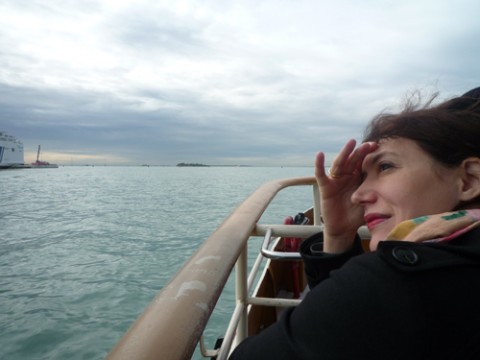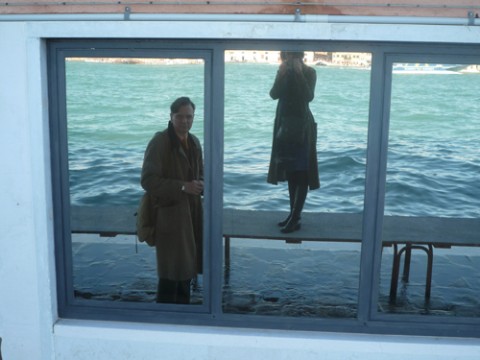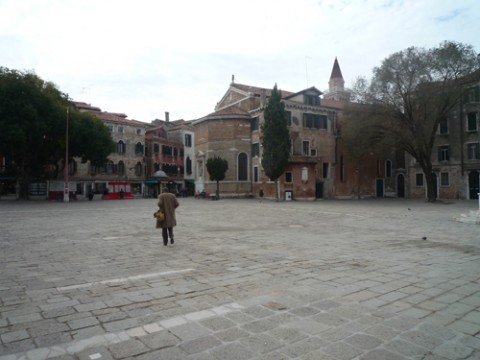Postcard from Venice
I had meant to write. I have a whole stack of postcards – even a pack I bought at a church that had obviously been taken in the early 1950’s – full of strong jawed gondoliers assertively clutching their oars and gazing over the Grand Canal like the early explorers must have looked out over the Grand Canyon. But, alas, here I am back in NYC and the postcards are still blank.
A week goes quickly. And if one vacations with David there seems to be an endless number of churches – especially in Venice, where there are an endless number of churches. Out early, we would walk all day and into the night, with momentary pauses on benches, in cafes, in churches, museums and trattorias. Not surprising, a lot of time was spent circuitously navigating between benches, cafes, churches, trattorias… One is never exactly lost, but is often unable to achieve the desired destination with any kind of speed or accuracy. In the pauses I had – generally sitting on a pew in one or another of the churches, I would jot down thoughts geared towards a single portrait of the city – but I find the jottings as diverse as the routes we took each day. So uncollated they will remain. Many other impressions are too vague even to jot down and I suppose they will stay or disappear in the random logic of remembrance since I cannot give them form on the page.
A lot of Venice is so scenic and packed with tourists – but like other parts of Italy the tourists seem to stay on the same 3 streets – leaving the rest basically empty. One knows and one gets the feeling even without knowing the fact that not many people actually live in Venice anymore. It is cleaned up. I realized looking at the Prendergast in Italy exhibition at the Guggenheim that something of the essence is no longer. There was a dirtiness of the sort depicted in the Naturalism of 19th century novels that the Carnevale was in opposition to and also celebrated, the economic and class systems which it could briefly supplant. Masks…Lanterns…Lace…Glass… an incandescence which needed night and faded with the day. A Venice like the paintings of Vanity where an shriveled and painted old woman gazes at her young self in the mirror. Present day Venice has had a bit or work done, her skin stretched into something more artificial, less true to either maid or the mask.
Absence compounds
So many overlapping threads and time softened glimpses – to decipher would be like trying to pull out a knot in the thinnest chain – the strands of my thoughts fuse and break. As If thought were the old cloth of a storm just past, shredding the clouds into rags. I cannot retain a route but only random scraps of images. A certain square passed through upon arrival, while I was dazed and jetlagged, remains unfound. But the absence of the longed for place recreates its color and proportion in my mind, amplifies its beauty through its absence and my desire to see it again.
If I were Italo Calvino I might write that the founders of Venice disagreed terribly in the design of their city. The best architects brought plans to the Doge and the wisest men argued well for each. At the end of the day no decision was reached. The plans were left in a stack on the table and all retired to their beds. During the night there was a great storm. It loosed the shutters and let through great gusts of rain and wind. In the morning the
Doge, the wise men, the architects all returned and find their plans strewn onto the floor, fused into a single translucent vellum which made plain grid over opposing grid. And this was maze that they built.
The knowing of this city would be boon to either predator or prey. There are as many escapes as their are dead ends.
Ghosts
Elaine Scarry might say there is a logic to my love of the Campo San Polo. The trees still have their leaves, but they are the willowy leaves of a Corot – reduced by the change of season or eaten away by insects into a grey green smoke – a translucent lace which is less seen than seen through. Scarry might say that it is the ghostlike transparency of the leaves reifies the solidity of those things seen through it. The tree as translucent as memory itself charges its environment with a greater opacity even in my mind’s poor copy. This place I can recall better because my mind recreates its ghost and its ghostliness.
Padua
Roasted chestnuts. The smoke filling the square. On the train coming back my skin and coat smell of that sweet smoke.
I feel like Santa Lucia after staring so hard at the Giotto’s in the Scrovegni chapel. The mere minutes I am allotted pass too quickly and though I rushed to take in each scene I am but halfway through in my looking. I ask and am rewarded and so go back in a second time – then the guard lets me stay on a third – my eyes on a plate.
Navigation
David remembers churches, scuolas and the relationship between. It is easier to navigate by such landmarks. Locations I remember best did not find their way onto the map. Such landmarks I used were the bench where the man fed pigeons, the campo with the grey dog that David met at the café, the wall the fig tree leaned over, the bridge and its radius scented by some strange bloom – some passion flower or tropical vine…
Water into Wine
One opportunity lost – there was a place where one could take a plastic water bottle and have it filled with another nectar entirely.
 Flickering
Flickering
The Venice remembered begins to recall the Venice imagined. Seeing the Mondrian “Sea” hanging on the wall next to the window looking out over the Grand Canal, I saw the painting and the premise as I had not before. I also enjoyed the cubist paintings at the Guggenheim – one might think that Peggy’s obsession with Picasso and his school lead her to Venice. It is a city of overlap and multiplying memory – one can’t take it in from a single point of view. Here memory is more useful than any compass.

